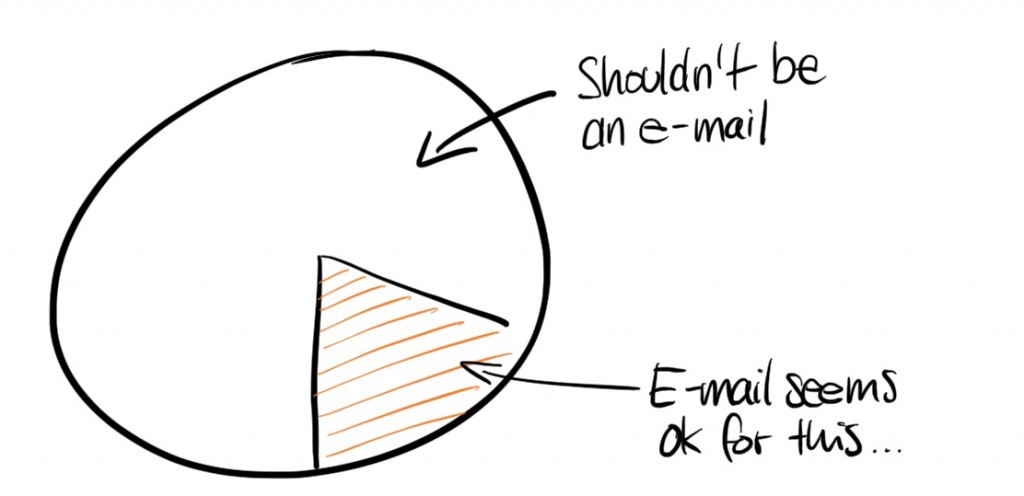It’s not “e-mail” that’s broken…
If we took all the e-mails produced by a company over the period of one year and looked at it from a “could there have been a better option than e-mail” perspective, I truly believe this is what it would look like:

No matter what the alternative could have been, in the majority of cases email wasn’t the right vehicle for moving a message from A to B. For a small minority of cases, it probably was.
I’ve never seen any in-depth content or interaction analysis of corporate e-mail usage beyond end user surveys. But, since e-mail has turned into this intrusive curse, chasing information workers relentlessly across devices and time zones like a sinister spirit, it is clear that something’s not ok.
With the Millennials entering the workplace, this creeping feeling about e-mail has escalated further. Which hoody-wearing future talent would even consider information exchange through this antiquated medium? They Facebook, tweet, WhatsApp, Instagram or Snapchat their way through an always-on world, right?
With the intent of solving this challenge, tech companies from all over the world are introducing entirely new ways of communication to companies. Social Media in the workplace is here. What works in the private world so splendidly, must surely be the solution to the mind numbing avalanche of e-mail in the business world, mustn’t it? So the evangelists have started preaching the bright future of productivity, networking and corporate culture.
We don’t seem to have stopped at any time however, and considered the question: why is e-mail broken? Or: is e-mail even broken at all?
E-mail wasn’t built for real-time communication exchange. It was never designed for collaborating on information and documents. It should never have become the only reliable channel through which “need to know” information could be delivered.
Without even realising it, companies have managed to turn e-mail into the foundation of any business or support process. Over the course of two decades, the global workforce has been gradually conditioned to believe that e-mail is the only way for businesses to interact and exchange information digitally.
Even the good old phone call has fallen victim to the short two line message that can be so conveniently fired off between meetings. It’s really no surprise that what used to be a status symbol of “importance” has turned into a curse in the workplace.
Of course, if we insist on using e-mail for things it was never intended, it will seem broken. But then its on us, not e-mail itself.
“If we insist on using e-mail for things it was never intended, it will seem broken. But then it's on us, not e-mail itself.” — Philipp Rosenthal”
Sometimes, a letter is appropriate.

Well, not literally of course. When I say “letter”, I don’t mean the physical piece of paper. A letter in this context is a well considered message. A message that is sent to one or more recipients through an established channel. It conveys a certain level of formality and may be left unread until time allows. A letter can be important but isn’t necessarily urgent. Its recipients are clear and so is the sender.
I believe there are use cases that allow for, or even demand, something other than an instant message, a feed post or an entry in a discussion board. Sometimes popping over a text or answering with an emoji is even outright rude. And sometimes e-mail is the only way anyway, because there simply isn’t any other common channel a group of people share.
Just recently I watched a scene in the Netflix series “The Crown”, in which Queen Elizabeth sat down to write a letter. Before sitting down she paced back and forth, thinking about what she wanted to say. Then she took a piece of paper, opened a fountain pen and took a deep breath before writing the first lines.
This is how we should use e-mail: deliberate, thought through, with a clear objective in mind. The goal should be to convey a message to the recipient, not to just fire it off and be done with it. The format itself should be a clear signal of intent: here is something I need you to really digest and understand. Therefore I have taken the time to write it down. Read it when you have the time.
We can make e-mail great again. Really.
If we as senders take our communication pace down a notch, we will re-gain time to think about how to write what, to who, and where. After that we can still fire away our chat messages, newsfeed posts and collaboration space comments where appropriate.
Occasionally however, we need to sit down and think for a while, take the time to write a text and choose our words and recipients carefully. Then, sign it and send if off, knowing that at the other end of the line someone will appreciate the format and wait until all the posts, messages and comments have gone quiet to then read our message, consciously and with intent.
Having the best of both worlds is possible.
At Fleep we believe in consolidating communication throughout your organization. Most modern day communication tools almost manage this.
It has become standard to expect chat tools to include messaging, voice and video calls and to let you save and share files easily as a minimum. But Fleep takes things one step further integrating with e-mail. This means you can add people to conversations and teams with their email address and they’ll receive messages as emails until they sign up to Fleep.
The very nature of this should help to foster asynchronous, considered communication within a chat app.
We realise that email has been the tool of choice for a very long time and is still at large in many organisations today. It may even have its place in some scenarios. So while we believe that change is inevitable, we’re committed to making the process of unifying your communication channels less painful by keeping them all in one place.
Sign up and trial Fleep today!
Further Reading:

